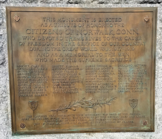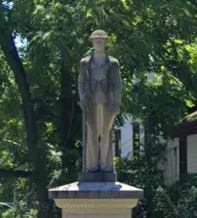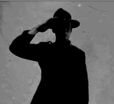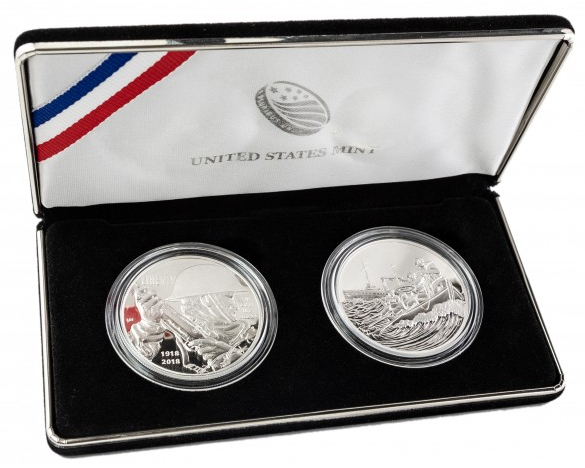Memorial Virtual Explorer app gets new look, new contents, public beta status
The National World War I Memorial Explorer augmented reality (AR) app, with great input from the initial beta testers, has been updated with expanded content, more functionality, and a new lead image and updated logo.
 The app has now expanded to public beta, and we're able to accommodate many more testers with a simplified request process.
More content is in production including Tanks, Military Battles, The life and family of General John J. Pershing, Artillery, a 360° Photosphere travel experience at the US Cemetery in Flanders, and a second exploration in the style of the "Sinking of the Lusitania" called "War in the Skies”.
We will be updating the existing beta release based on tester feedback in the next couple of weeks. If you haven't volunteered to join our beta tester army, click here to sign up now!
National World War I Museum and Memorial Sets June Reopen Dates

The National WWI Museum and Memorial will reopen to its members on Monday, June 1 and to the general public on Tuesday, June 2. “We have monitored the COVID-19 situation closely during the past few months and, in accordance with guidance from public health officials at the local, state and federal levels, we are ready to reopen America’s official WWI Museum and Memorial,” said Dr. Matthew Naylor, National WWI Museum and Memorial President and CEO. “We’ve spent considerable time developing a comprehensive reopening plan that allows for people to visit one of the world’s great museums and memorials in a safe and welcoming environment.” Click here to find out more about the Museum's plans and protective protocols to get visitors into the Kansas City facility again next week.
|

Connecticut USAF veteran Jeff DeWitt undertook a personal project in 2019 to find and photograph the plaques on local war memorials that listed only the names those who died during wartime service. He found that "What struck me most about it all was how little I knew about each of those people. It was then that I decided to tell their stories." On the Norwalk WWI Memorial, "One plaque has only the names of those who died in service 1917 to 1919. I recognized three people on that plaque who are namesakes of our VFW and American Legion posts in town. The rest were a complete mystery to me." Click here to read how DeWitt went about solving those 100 year-old mysteries, and bringing forgotten stories of service to light again.
|
Writing in the Washington Examiner newspaper, J. Mark Powell notes that "a deadly combination of war and pandemic" made October 1918 the deadliest month in our nation's history. Click here to read the entire story about how "More U.S. citizens died then than ever passed away during any 30-day stretch before or since."
As today, in cities across the nation, dealing with the flu pandemic took center stage a century ago. The WTTW television station recently looked into the question of "How Did Chicago Deal With 1918 Spanish Flu?" The Hudson Heritage Association in Ohio was recently "Looking back at ‘displays of humanity’ in Hudson, OH" during the Spanish Flu Pandemic. The Oregon Historical Society asks "From Whence Did it Come and to Where Did it Go?: The 1918 Influenza Pandemic in Oregon." The Knoxville History Project explores "Knoxville & The Spanish Flu: How 1918 was the same–and very different." And the Phillips Academy in Andover, MA reflects on "Lives lost and the country at a standstill: A look back back at the 1918-1919 Spanish Influenza and its impact on Phillips and Abbot academies."

A statue of a World War I infantryman in Falls Township, PA’s Fallsington section will be restored. The limestone Doughboy statue that sits atop a small memorial at the intersection of Yardley Avenue, New Falls Road, Main Street, and West Tyburn Road has become weathered and damaged over the years. Acid rain and pollution have taken their toll on the statue erected to recognize the veterans and casualties of World War I. Click here to read more about the community restoration project for this century-old monument.
|

A man is only missing if he is forgotten.
World War One.
It was the first war where America made the promise: 'Everyone comes home - nobody gets forgotten.'
And in the years following the war, America did her best to keep that promise to the best of her ability.
One hundred years later, Doughboy MIA has 4,452 reasons to continue that work.
Join us on a webinar Friday, May 29, and learn about The Who, The Where, and The Ways and Means behind what it is we do.
“A Man is Only Missing if He is Forgotten” is the slogan of Doughboy MIA, and after this webinar you’ll understand the efforts to ensure that all the MIA are properly remembered, and how you can be a part of the effort.
Would YOU like to be a part of our mission of discovering what happened to our missing Doughboys from WW1? Of course you would, and you CAN! Simply make a donation to the cause and know you played a part in making as full an accounting as possible of these men. Large or small doesn’t matter – that you cared enough to help does. Visit www.ww1cc.org/mia to make your tax deductible donation to our non-profit project today, and remember:
A man is only missing if he is forgotten.
|

No longer available from the U.S. Mint!
These Official World War I Centennial Silver Dollar Sets are still available here on the WWI Centennial Commission's online gift shop.
NOTE: Each set comes with 2 separate coins. Each set will accompany the Official Doughboy Design alongside your choice of Military Branch.
"The United Mint certifies that this coin is a genuine 2018 World War I Centennial Silver Dollar, minted and issued in accordance with legislation passed by Congress and signed by the President on December 16, 2014, as Public Law 113-212. This coin was minted by the Department of the Treasury, United States Mint, to commemorate the centennial of America's involvement in World War I. This coin is legal tender of the United States."
Proceeds from the sale of this item will help build the new National World War I Memorial in Washington, DC.
This and many other items are available as Official Merchandise of the United States World War One Centennial.
|